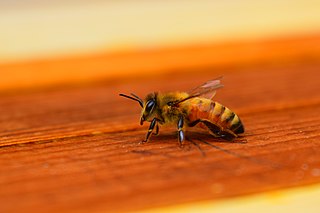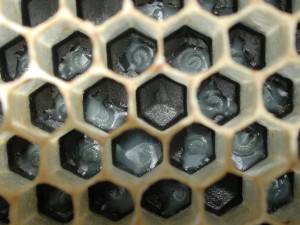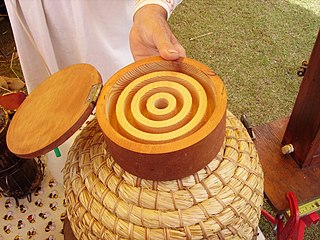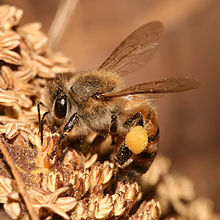
Bees are winged insects closely related to wasps and ants, known for their roles in pollination and, in the case of the best-known bee species, the western honey bee, for producing honey. Bees are a monophyletic lineage within the superfamily Apoidea. They are currently considered a clade, called Anthophila. There are over 20,000 known species of bees in seven recognized biological families. Some species – including honey bees, bumblebees, and stingless bees – live socially in colonies while most species (>90%) – including mason bees, carpenter bees, leafcutter bees, and sweat bees – are solitary.

Honey is a sweet and viscous substance made by several species of bees, the best-known of which are honey bees. Honey is made and stored to nourish bee colonies. Bees produce honey by gathering and then refining the sugary secretions of plants or the secretions of other insects, like the honeydew of aphids. This refinement takes place both within individual bees, through regurgitation and enzymatic activity, and during storage in the hive, through water evaporation that concentrates the honey's sugars until it is thick and viscous.

A honey bee is a eusocial flying insect within the genus Apis of the bee clade, all native to mainland Afro-Eurasia. After bees spread naturally throughout Africa and Eurasia, humans became responsible for the current cosmopolitan distribution of honey bees, introducing multiple subspecies into South America, North America, and Australia.

Pollination management is the horticultural practices that accomplish or enhance pollination of a crop, to improve yield or quality, by understanding of the particular crop's pollination needs, and by knowledgeable management of pollenizers, pollinators, and pollination conditions.

Bee learning and communication includes cognitive and sensory processes in all kinds of bees, that is the insects in the seven families making up the clade Anthophila. Some species have been studied more extensively than others, in particular Apis mellifera, or European honey bee. Color learning has also been studied in bumblebees.

In beekeeping, bee brood or brood refers to the eggs, larvae and pupae of honeybees. The brood of Western honey bees develops within a bee hive. In man-made, removable frame hives, such as Langstroth hives, each frame which is mainly occupied by brood is called a brood frame. Brood frames usually have some pollen and nectar or honey in the upper corners of the frame. The rest of the brood frame cells may be empty or occupied by brood in various developmental stages. During the brood raising season, the bees may reuse the cells from which brood has emerged for additional brood or convert it to honey or pollen storage. Bees show remarkable flexibility in adapting cells to a use best suited for the hive's survival.

A worker bee is any female bee that lacks the reproductive capacity of the colony's queen bee and carries out the majority of tasks needed for the functioning of the hive. While worker bees are present in all eusocial bee species, the term is rarely used for bees other than honey bees, particularly the European honey bee. Worker bees of this variety are responsible for approximately 80% of the world's crop pollination services.

Bee pollen, also known as bee bread and ambrosia, is a ball or pellet of field-gathered flower pollen packed by worker honeybees, and used as the primary food source for the hive. It consists of simple sugars, protein, minerals and vitamins, fatty acids, and a small percentage of other components. Bee pollen is stored in brood cells, mixed with saliva, and sealed with a drop of honey. Bee pollen is harvested as food for humans and marketed as having various, but yet unproven, health benefits.
Hive management in beekeeping refers to intervention techniques that a beekeeper may perform to ensure hive survival and to maximize hive production. Hive management techniques vary widely depending on the objectives.
This page is a glossary of beekeeping.

A feeder is a vessel or contraption used by beekeepers to feed pollen or honey to honey bees from a honey bee colony.

The dwarf honey bee, Apis florea, is one of two species of small, wild honey bees of southern and southeastern Asia. It has a much wider distribution than its sister species, Apis andreniformis. First identified in the late 18th century, Apis florea is unique for its morphology, foraging behavior and defensive mechanisms like making a piping noise. Apis florea have open nests and small colonies, which makes them more susceptible to predation than cavity nesters with large numbers of defensive workers. These honey bees are important pollinators and therefore commodified in countries like Cambodia.

The East African lowland honey bee is a subspecies of the western honey bee. It is native to central, southern and eastern Africa, though at the southern extreme it is replaced by the Cape honey bee. This subspecies has been determined to constitute one part of the ancestry of the Africanized bees spreading through North and South America.

The western honey bee or European honey bee is the most common of the 7–12 species of honey bees worldwide. The genus name Apis is Latin for "bee", and mellifera is the Latin for "honey-bearing" or "honey carrying", referring to the species' production of honey.

Colony collapse disorder (CCD) is an abnormal phenomenon that occurs when the majority of worker bees in a honey bee colony disappear, leaving behind a queen, plenty of food, and a few nurse bees to care for the remaining immature bees. While such disappearances have occurred sporadically throughout the history of apiculture, and have been known by various names, the syndrome was renamed colony collapse disorder in early 2007 in conjunction with a drastic rise in reports of disappearances of western honey bee colonies in North America. Beekeepers in most European countries had observed a similar phenomenon since 1998, especially in Southern and Western Europe; the Northern Ireland Assembly received reports of a decline greater than 50%. The phenomenon became more global when it affected some Asian and African countries as well. From 1990 to 2021, the United Nation’s FAO calculated that the worldwide number of honeybee colonies increased 47%, reaching 102 million.

Apis cerana, the eastern honey bee, Asiatic honey bee or Asian honey bee, is a species of honey bee native to South, Southeast and East Asia. This species is the sister species of Apis koschevnikovi and both are in the same subgenus as the western (European) honey bee, Apis mellifera. A. cerana is known to live sympatrically along with Apis koschevnikovi within the same geographic location. Apis cerana colonies are known for building nests consisting of multiple combs in cavities containing a small entrance, presumably for defense against invasion by individuals of another nest. The diet of this honey bee species consists mostly of pollen and nectar, or honey. Moreover, Apis cerana is known for its highly social behavior, reflective of its classification as a type of honey bee.

Bumblebees, like the honeybee collect nectar and pollen from flowers and store them for food. Many individuals must be recruited to forage for food to provide for the hive. Some bee species have highly developed ways of communicating with each other about the location and quality of food resources ranging from physical to chemical displays.
Honey bee starvation is a problem for bees and beekeepers. Starvation may be caused by unfavorable weather, disease, long distance transportation or depleting food reserve. Over-harvesting of honey is the foremost cause for scarcity as bees are not left with enough of a honey store, though weather, disease, and disturbance can also cause problems. Backyard beekeepers face more colony losses in the winter than in the summer, but for commercial beekeepers there is not much variation in loss by season. Starvation may be avoided by effective monitoring of hives and disease prevention measures. Starvation can amplify the toxic effect of pesticides bees are exposed to.
















